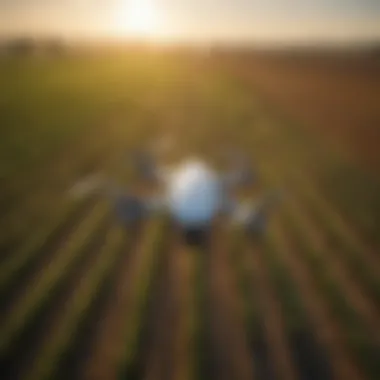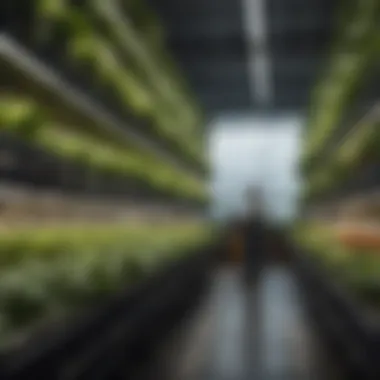Innovative Strategies for Sustainable Agriculture


Intro
Agriculture is undergoing a transformation. New technologies and methodologies are not just enhancements; they are essentials for the future. As the world's population continues to grow, the pressure on agricultural systems increases. This necessitates innovative thinking and a shift toward sustainable practices. Every farmer or agronomist must adapt to this evolving landscape. The aim of this article is to shed light on cutting-edge solutions that ensure both productivity and sustainability in agriculture.
Research and Data Analysis
Understanding the latest trends in agriculture is crucial for adapting to market demands and environmental changes.
Latest Trends in Agriculture and Horticulture
Recent studies show a shift toward organic farming, regenerative agriculture, and the use of precision agriculture technologies. Drones for monitoring crop health, sensors for soil moisture, and mobile applications for real-time data are gaining traction. The integration of these technologies facilitates informed decision-making. Farmers can optimize inputs like water and fertilizers, which results in reduced waste and increased efficiency.
Statistical Insights into Crop Yields
Data analysis plays a pivotal role in enhancing crop yields. According to the Food and Agriculture Organization, global crop production needs to rise by 70% by 2050 to meet food needs. Statistical insights reveal significant advancements in crop yields facilitated by genetically modified organisms (GMOs), optimized planting methods, and crop rotation strategies. For instance, countries like Brazil and the USA have seen a considerable increase in soybean yields due to genetically engineered seeds that withstand pests and drought.
"Innovation in agriculture is no longer optional; it is necessary to ensure food security for the future."
Best Practices and Techniques
Implementation of best practices ensures that farmers utilize their resources wisely.
Efficient Crop Management Strategies
Utilizing integrated practices can dramatically enhance efficiency. Strategies include:
- Crop rotation: This combats pests and enhances soil fertility.
- Precision agriculture: Using GPS technology helps in accurate field mapping.
- Soil health management: Employing cover crops improves soil quality and structure.
Sustainable Horticultural Techniques
Sustainability in horticulture is achieved through mindful methods. These include:
- Organic pest control: This reduces reliance on synthetic pesticides.
- Drip irrigation: This technique conserves water while ensuring plants receive adequate moisture.
- Companion planting: Certain species can repel pests naturally, promoting biodiversity.
Pest and Disease Management
Managing pests and diseases is critical for maintaining healthy crops.
Common Pests and Diseases in Crops
Farmers often face threats from various pests and diseases. Some common ones are:
- Aphids
- Whiteflies
- Fungal diseases like powdery mildew
Recognizing these threats early is essential to mitigate their impact on yield.
Integrated Pest Management Strategies
Integrated Pest Management (IPM) combines biological, cultural, and mechanical strategies. This approach reduces reliance on chemicals while promoting ecological balance. Effective measures include:
- Regular monitoring: Observing pest populations helps in timely interventions.
- Biological control: Utilizing natural predators can effectively control pest populations.
- Cultural practices: Crop diversity and tillage can suppress pest emergence.
Epilogue
In summary, the agriculture sector stands at a crossroads. Embracing cutting-edge solutions and best practices is needed to fulfill the demands of a growing global population. Adapting to sustainable innovation is the best path to a resilient agricultural future.
Preamble to Cutting Edge Solutions
The agricultural industry constantly faces challenges that demand innovative approaches to sustain productivity and meet the needs of a growing population. This makes the concept of cutting edge solutions crucial. Cutting edge solutions refer to the latest advancements and methodologies that enhance agricultural practices, from crop management to resource allocation. Understanding these innovations is essential for farmers and industry stakeholders seeking to optimize their operations and maintain competitiveness in the global market.
Definition of Cutting Edge Solutions
Cutting edge solutions in agriculture encompass technologies and practices that are at the forefront of agricultural science. These solutions are often based on the integration of advanced tools and techniques. Examples include precision agriculture, biotechnology, and sustainable farming practices. The aim of these solutions is to maximize efficiency, reduce waste, and ultimately improve crop yields while minimizing the environmental impact.
Importance of Innovation in Agriculture


Innovation plays a pivotal role in agriculture. It not only contributes to higher productivity but also addresses pressing global issues like food security and climate change. By adopting innovative practices, farmers can:
- Improve crop resilience to changing climate conditions.
- Achieve sustainable use of resources through eco-efficient techniques.
- Enhance the quality of produce that meets consumer expectations.
Innovation can also lead to cost savings and better management of agricultural operations. As the world evolves, embracing cutting edge solutions is no longer optional; it is essential for survival in the competitive agricultural landscape.
"Innovation in agriculture is about turning challenges into opportunities, ensuring the future of farming."
Transitioning to modern agricultural practices requires not only investment in technology but also a cultural shift within the sector. This mindset change encourages farmers to explore and adopt new methods, ensuring that agriculture can thrive in a rapidly changing environment.
The Role of Technology in Modern Agriculture
Technology is a vital component in modern agriculture. It helps farmers enhance their productivity, minimize risks, and create sustainable practices. Farmers today face numerous challenges like climate change, resource depletion, and increasing food demand. Therefore, integrating technology into farming practices is not merely advantageous; it is essential.
Recent developments have shown that adopting technology has transformed many agricultural operations. It allows for better crop yields, resource management, and overall efficiency. This section discusses the various technological advances making a significant impact on agriculture, focusing specifically on emerging technologies, data analytics, and automation.
Emerging Technologies Shaping Agriculture
Emerging technologies are influencing agriculture in various ways. Tools such as drones, smart sensors, and genetic engineering are changing the landscape of farming. Drones play a key role in monitoring crop health and managing fields effectively. They provide aerial views that give farmers the vital data needed to make informed decisions.
Smart sensors collect valuable data on soil conditions, moisture levels, and weather patterns. This information assists farmers in applying water and nutrients precisely when and where they are needed.
Genetic engineering advances have also led to the development of crop varieties that are more resistant to pests and diseases. These varieties can thrive in less than ideal conditions. This not only boosts productivity but also reduces the need for chemical inputs.
Impact of Data Analytics on Crop Production
Data analytics is transforming how farmers approach agriculture. By analyzing historical data, farmers can predict crop performance and make decisions based on empirical evidence. This reduces uncertainty in the farming process. With the help of advanced analytical tools, they can assess factors such as weather forecasts, market trends, and soil health. These insights enable farmers to optimize their practices and resources better.
Through data analytics, farmers can implement tailored strategies for their specific conditions. For example, precision farming techniques rely on data to inform decisions about planting times and crop selection.
"The future of farming lies in the ability to harness data effectively". This statement underscores the crucial role of data analytics in agriculture.
Automation in Farming: A Necessity
Automation technology is becoming a necessity in today's agricultural landscape. Machines now perform many tasks that were once labor-intensive, such as planting, harvesting, and irrigation. This shift allows farmers to focus on higher-level management tasks.
Robotic systems can monitor crops and manage fields with precision. They reduce labor costs and increase productivity. For instance, automated irrigation systems save water by applying it only when needed, while robotic harvesters can work faster and more efficiently than human laborers.
The adoption of automation is not only about efficiency but also about overcoming labor shortages in the agriculture sector. As younger generations move away from farming, leveraging technology helps sustain agricultural productivity.
Precision Agriculture: Enhancing Efficiency
Precision agriculture stands as a pivotal concept in modern farming, aimed at elevating efficiency and sustainability through the adoption of data-driven techniques. As the global population continues to surge, the demand for food escalates, making the optimization of agricultural practices more critical than ever. This section delves into precision agriculture by discussing its introduction, tools, and successful case studies that showcase its effectiveness.
Prolusion to Precision Agriculture
Precision agriculture is defined as a farming management concept that uses information technology to ensure that crops and soil receive exactly what they need for optimal health and productivity. Instead of a one-size-fits-all approach, this method tailors farming inputs to the specific conditions of each field and even each plant. Key aspects of precision agriculture include the use of Geographic Information Systems (GIS), Global Positioning System (GPS) technology, and remote sensing.
One of the primary benefits of precision agriculture is its ability to enhance resource management. Farmers can apply fertilizers and water more strategically, reducing waste and minimizing environmental impacts. This method also enables farmers to monitor crop health closely, allowing for timely interventions when issues arise, thus promoting better yield quality.
Tools and Techniques for Precision Farming
Numerous tools and techniques contribute to the effective implementation of precision agriculture. Some notable tools include:
- GPS Technology: Utilized for accurate mapping of fields, guiding machinery during planting and harvesting.
- Soil Sensors: Employed to gather data on soil moisture levels, temperature, and nutrient availability.
- Drones: Provide aerial imagery that can identify plant health issues and assess crop growth effectively.
- Variable Rate Technology (VRT): Allows for the application of inputs at varying rates across a field based on specific needs.
Adopting these tools requires a significant initial investment, but the long-term savings and increased yield potential often justify the costs. Furthermore, integrating these technologies can lead to higher levels of sustainability by reducing chemical runoff and conserving resources.
Case Studies: Successful Implementations
Real-world applications of precision agriculture illustrate its enormous potential. For example, the case of a corn farm in Iowa incorporates GPS and yield mapping to optimize fertilizer applications. By analyzing yield data, the farmer identified underperforming areas to apply more nutrients specifically where needed. As a result, the farm reported a significant increase in yield while lowering fertilizer costs.
Another successful implementation took place in Australia, where a vineyard used drones combined with thermal imaging to diagnose irrigation needs. By identifying areas needing more water, the vineyard improved its water use efficiency and grape quality, leading to a better product with minimal environmental impact.
"Precision agriculture not only benefits the farmer but also supports the global goal of sustainable practices, ensuring we can feed a growing population without exhausting natural resources."


Sustainable Practices: Moving Towards Eco-Friendly Solutions
Sustainable practices are essential in modern agriculture, especially as the world faces growing challenges such as climate change, resource depletion, and loss of biodiversity. This section will explore various sustainable practices that can help foster eco-friendly solutions in agricultural operations. By adopting these methods, farmers not only improve productivity but also contribute positively to the environment.
Importance of Sustainability in Agriculture
Sustainability in agriculture refers to practices that maintain ecological balance while ensuring the long-term viability of farming. The importance of sustainability cannot be overstated. It encompasses ways to produce food that do not compromise future generations' ability to meet their needs. Key benefits of sustainable practices include:
- Reduced environmental impact: Sustainable farming helps to minimize pollution, conserve water, and maintain soil health.
- Enhanced food security: By adopting practices that ensure longevity and resilience of crops, farmers can contribute to food security on a global scale.
- Economic viability: Sustainable methods often lead to cost savings through efficient resource use, reducing reliance on expensive inputs.
"Sustainable agriculture is not just about the environment; it is about creating a balanced system that respects nature while ensuring economic benefits for farmers."
Organic Farming and Its Benefits
Organic farming eliminates the use of synthetic fertilizers and pesticides, focusing on natural methods to enhance soil fertility and pest control. This approach offers numerous benefits:
- Healthier soil: Organic practices promote biodiversity in the soil, leading to increased nutrient availability and improved crop yield.
- Lower chemical exposure: Consumers benefit from reduced pesticide residues in food, enhancing public health.
- Biodiversity protection: Organic farms often support a diverse array of plants and animals, contributing to a healthier ecosystem.
Integrating Biodiversity in Farming Practices
Biodiversity in farming fosters resilience and sustainability. Integrating diverse species can benefit agricultural systems in various ways. Here are some important aspects to consider:
- Crop rotation: Alternating different crops throughout the growing seasons can enhance soil health and reduce pest issues.
- Polyculture systems: Cultivating multiple crops in the same space encourages natural pest control and improves overall yield.
- Native species: Incorporating native plants into farming can enhance local ecological networks and provide habitat for beneficial insects.
By embracing sustainable practices, the agricultural sector can play a significant role in mitigating environmental challenges while enhancing productivity. Farmers and agricultural enthusiasts should view these approaches not as constraints, but as opportunities for innovation and resilience.
Bulletproof Strategies for Implementing Innovations
Implementing innovations in agriculture is not a trivial task. It demands a strategic approach that ensures sustainability and productivity. This section provides practical insights on how farmers can effectively implement cutting-edge solutions. These strategies are crucial in navigating the complexities of modern agriculture, ensuring that innovations lead to tangible benefits.
Assessing Needs Before Implementation
Before any innovation is adopted, it is vital to conduct a thorough assessment of specific needs. Understanding the particular challenges faced on a farm helps in tailoring solutions effectively. Factors such as soil health, crop type, and local climate should influence decisions on new technologies or practices.
Moreover, farmer consultations may provide deeper insights into common issues, leading to targeted innovations. For instance, if pest management is a significant concern, investing in precision agriculture tools that utilize drone technology may be prioritized.
Comprehensive assessments can also help identify resource gaps that need addressing. This methodical approach reduces the risk of costly mistakes during implementation, ensuring that resources are invested where they are most needed.
Investment in Training and Education
Investing in the training and education of stakeholders is another key strategy. As new technologies emerge, it’s essential that farmers and agricultural workers understand how to use them effectively. Training programs should cover not just the technical aspects of the new tools but also the rationale behind them.
For example, understanding the principles of data analytics in agriculture can enable farmers to make informed decisions based on metrics. Workshops, online courses, and community seminars can play a pivotal role in this educational journey. Such initiatives help cultivate an informed workforce, ready to embrace change and innovation.
Additionally, training fosters a culture of continuous learning. This is important in an industry that evolves rapidly with new methodologies. As the awareness expands, adaptation becomes smoother, mitigating resistance to change.
Monitoring and Evaluation of Outcomes
Monitoring and evaluating innovations after implementation is crucial to understand their effectiveness. This process involves setting measurable goals and regular assessments. For example, if a precision farming tool is adopted, its impact on crop yield should be tracked over time.
Feedback loops should be established so that findings can inform future innovations. Consistent monitoring can identify areas needing adjustment, ensuring that techniques evolve with changing conditions. This adaptability is key in an industry heavily influenced by external factors like climate change and market demands.
Farmers should also consider collaboration with local agricultural agencies or universities for evaluations. These partnerships can offer valuable insights and resources, enhancing the overall effectiveness of the new strategies.
"Effective implementation of agricultural innovations not only increases productivity but also promotes sustainability, ensuring a healthy future for farming."
In summary, each aspect of the implementation strategy holds significant importance. From assessing needs to education and consistent monitoring, these strategies create a framework for successful adoption of innovations. Prioritizing these elements equips farmers to face the challenges of modern agriculture, ensuring that innovations drive meaningful progress.
Challenges in Adopting Cutting Edge Solutions
As agriculture continuously evolves, the integration of cutting-edge solutions is paramount. Nonetheless, various challenges impede the adoption of innovative strategies in this field. Understanding these challenges is essential for industry stakeholders aiming to embrace technology and sustainability in agriculture. Addressing financial barriers, resistance to change, and regulatory constraints provides a clear path forward for farmers and agribusinesses.
Financial Barriers for Farmers
Financial constraints represent one of the most significant hurdles facing farmers when adopting new technologies. Many farmers operate on thin margins, making large investments into cutting-edge solutions seem risky. The cost of equipment, software, and training can be daunting. For example, the initial outlay for precision agriculture tools can run into thousands of dollars, which many small-scale farmers cannot afford.


Moreover, access to financing is also limited. Traditional lending institutions may not understand agricultural advancements or view them as high-risk ventures. Consequently, farmers are left with minimal options. This situation leaves them vulnerable and reluctant to invest in much-needed innovations. Addressing these financial barriers could enhance accessibility for a broad range of farmers.
Resistance to Change within the Industry
The agricultural sector is traditionally known for its adherence to established practices. Resistance to change can stem from various factors, including fear of the unknown, lack of information, or skepticism about new technologies. Many farmers may question the efficacy or long-term benefits of cutting-edge solutions, preferring familiar methods.
Culturally, farming communities often prioritize relationships built over generations. Shifting to data-driven decisions or adopting automated processes may be seen as a threat to values that hold deep-rooted significance. For instance, older generations might struggle to see the relevance of drones and satellite imagery in making farming decisions. Education and communication are vital here, as they can bridge the gap between trust in conventional methods and the potential advantages of adopting new technologies.
Regulatory and Policy Constraints
Finally, regulatory and policy constraints pose further challenges to the adoption of innovative agricultural solutions. Farmers must navigate an intricate landscape of laws, regulations, and standards that may not always align with new practices. For example, issues regarding data privacy arise with the use of technologies that collect extensive user data. These regulations can inhibit farmers from leveraging full capabilities of cutting-edge solutions.
Additionally, policy frameworks can be slow to adapt to technological advancements. Compliance with outdated regulations can create obstacles, discouraging farmers from pursuing innovative strategies. Advocacy for policy reform is necessary to support sustainable practices while ensuring that regulations promote, rather than stifle, agricultural innovation.
By addressing these challenges, we can foster an environment conducive to adopting cutting-edge agricultural solutions, further ensuring the industry's progression towards sustainability and productivity.
Future Trends in Agricultural Innovation
Understanding future trends in agriculture is imperative for ensuring that the industry adapts to changes in technology and consumer expectations. Innovations not only enhance productivity but also promote sustainability, which is crucial in modern farming. By examining these trends, farmers can better align their practices with global needs and prepare for an increasingly competitive market.
Predicted Advancements in Biotechnology
Advancements in biotechnology promise to revolutionize crop production in the coming years. Genetic engineering and CRISPR technology are two areas that are leading this change. These tools allow for precise manipulation of plants to enhance desirable traits such as disease resistance, drought tolerance, and yield increases.
- Biotech crops have the potential to reduce the necessity for chemical inputs. This benefits not only the farmers financially but also the environment by lowering pesticide use.
- Enhanced nutrient profiles in crops can lead to improved human health, as food produced can contain higher amounts of vitamins and essential minerals.
As these technologies become mainstream, regulatory environments will need to evolve to ensure safety while encouraging innovation. Farmers should stay informed about the available biotech solutions to utilize these advancements effectively.
The Role of Artificial Intelligence in Agriculture
Artificial intelligence (AI) is set to transform agricultural practices in numerous ways. Machine learning algorithms can analyze vast amounts of data, providing insights that assist farmers in decision-making processes. Key areas where AI is having an impact include:
- Predictive analytics: AI can analyze weather patterns and historical crop performance to forecast yields, helping farmers plan their activities better.
- Precision application: Automated systems can apply fertilizers and pesticides with pinpoint accuracy, thereby minimizing waste and environmental impact.
"The integration of AI in agriculture can lead to significant improvements in efficiency and sustainability."
By employing AI-powered tools, farmers can streamline their operations and reduce their environmental footprint. This will also allow them to meet the growing consumer demand for sustainably produced food.
Global Collaboration for Agricultural Solutions
Global collaboration is vital for addressing the challenges that agriculture faces today. Climate change, resource scarcity, and population growth are complex issues that require coordinated efforts among various stakeholders. Collaborative initiatives can lead to:
- Knowledge sharing: Farmers around the world can share best practices and innovative techniques that have worked in different environments.
- Research partnerships: Universities, research institutions, and companies can work together on developing new technologies, ensuring that advancements are practical and accessible.
Facilitating discussions between countries can also lead to agreements that promote sustainable agricultural practices on a global scale. Farmers should engage with these collaborations to stay ahead in innovation and effectively contribute to global food security.
Finale: The Path Forward for Agriculture
In light of the extensive discussions throughout this article, it becomes clear that the future of agriculture lies in the integration of innovative solutions and sustainable practices. The global concerns about food security, environmental sustainability, and economic viability necessitate a decisive shift towards methodologies that harness technology and ecological awareness. It is not merely about increasing productivity. It is about doing so while maintaining the health of our ecosystems and ensuring that farming remains profitable for generations to come.
"The key to future agricultural success will be adaptability and resilience in the face of changing conditions."
This article has covered various aspects such as precision agriculture, biotechnology, and sustainable practices. Each of these elements plays a crucial role in shaping a more resilient agricultural framework. Sustainable innovation is not a mere trend; it is a necessity. Farmers and stakeholders are encouraged to look beyond traditional practices to adopt solutions that offer long-term benefits.
In summary, understanding the breadth of possibilities in agriculture today opens doors to potent strategies. Farmers must embrace technological tools, data analytics, and eco-friendly methods to enhance their productivity sustainably. With the guidance offered in the previous sections, it is plausible to approach the challenges ahead with confidence and clarity.
Summarizing Key Insights
As we conclude, several key insights emerge from our discussion:
- Innovation is crucial: The agriculture sector must adopt innovative tools that improve efficiency and sustainability.
- Precision agriculture enhances productivity: By utilizing technology for targeted resource management, farmers can optimize both yield and conservation efforts.
- Sustainability is non-negotiable: Practices that harm the environment must be reassessed and replaced with more eco-friendly alternatives.
- Collaboration is essential: Cooperation among stakeholders, from farmers to policymakers, fosters an environment conducive to meaningful change.
Consider these points carefully as they will guide future strategies in agriculture.
Call to Action for Industry Stakeholders
It is imperative for all participants in the agricultural ecosystem to take proactive steps. Here are some actionable recommendations:
- Invest in Training: Equip farmers with the necessary skills for new technologies through workshops and educational programs.
- Support Research Initiatives: Encourage and fund research that explores innovative agricultural practices.
- Foster Partnerships: Collaborate with tech companies, research institutions, and other organizations to bring more solutions to the market.
- Advocate for Policy Change: Engage in discussions about regulations that affect the implementation of new technologies and sustainable practices.
- Stay Informed: Regularly update oneself on the latest trends and solutions in agriculture to ensure competitiveness and resilience.
The responsibility to move forward lies in the hands of industry stakeholders. By taking these steps, the agricultural sector can work towards a sustainable and productive future.















